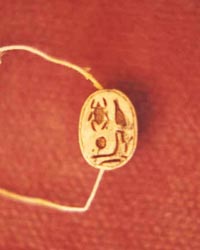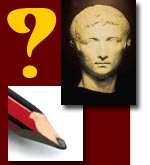| Site Map | Contacts | Links | Newsletter | |
Other Views:
Michael Sanders
There is a web site called Mysteries of the Bible produced by Michael Sanders. Sanders makes extraordinary claims, but lacks the extraordinary evidence to back them up.
Sanders claims to know where the Ark of the Covenant is!
Michael Sanders believes that the Ark is in the village of Djaharya in Israel. I think that his chronology and interpretation of Egyptian texts are off. The location at Djaharya sounds similar to Egyptian words, but similar sounds do not mean they are the same. I think Rohl in his books also assumes that similar sounding words must be the same. Djahi is a general area for part of Palestine and Phoenicia (See A Concise Dictionary of Middle Egyptian by Raymond O. Faulkner 1991, 319). I looked up all the occurrences of Djahi in ANET, and they do not seem to fit the location of Djaharya. Pekanan is literally "the Canaan" according to Breasted. The "Pe" is the article "the" plus "Canaan." (This is what I remember from taking Egyptian Hieroglyphics) Djahi and Pekanan are two different Egyptian words, that are general geographic terms, and should not be put together to form a new word Djahi Pakaanan. These two words seem to be used in parallel. There were a number of Egyptian Temples in Canaan not just in Djaharya. His web site about the Ark of the Covenant. More information about the Ark of the Covenant.
Sanders claims to know where the city of Sodom is!
Michael Sanders believes that Sodom and Gomorrah are on the bottom of the Dead Sea. He has even used a submarine to dive down to the bottom to see what is there. You can see pictures of this at Dead Sea.
The problem is that there is no evidence that this is Sodom. Sodom is most likely to be identified with the modern site name Bab edh-Dhra. Even in an earlier lecture Sanders seems to think that Bab edh-Dhra is Sodom (See Sodom & Gomorrah). Gomorrah is identified with Numeira. Walter Rast and Thomas Schaub excavated these sites starting in 1975. (See American Schools of Oriental Research (ASOR) website) The Smithsonian Institution has some of the remains of bones and pottery from Bab edh-Dhra in their Natural History Museum in the exhibit of "Origins of Western Culture" on the second floor. There was a total of five Early Bronze Age sites that matched the five cities of the plain mentioned in Genesis 14. Probably an earthquake caused an eruption of gas, oil, sulfur, salt, and bitumen to rain down on Sodom and Gomorrah. The Dead Sea is right on a fault line where earthquakes occur.
Sanders is all mixed up in his chronology!
Sanders cuts out several hundred years out of Egyptian chronology to make it fit with Biblical chronology. He seems to follow David Rohl's theories. Most scholars equate the Biblical Shishak with the Egyptian king Sheshonq I. Sanders rejects the evidence for this.
 |
Scarab of Sheshonq I. He ruled Egypt from 945-924 BC. |
The Hebrew name Shishak matches the Egyptian name of Sheshonq I in Egyptian history. Sheshonq is the founder of the 22nd Dynasty of Egypt. Sheshonq I ruled from 945-924 BC. He was from a Libyan tribe who became commander-in-chief, then King. He was a strong leader who reunited Egypt. 2 Chronicles 12:3-4 says, "With 1200 chariots and 60,000 horsemen and the innumerable troops of Libyans, Sukkites (mercenary Libyan soldiers) and Cushites (Upper Egypt) that came with him from Egypt, he captured the fortified cities of Judah and came as far as Jerusalem" (NIV). Note the many troops from Libya. Thutmose III nor Rameses II would not have had an army composed of mainly outsiders, but Egyptians. There are inscriptions of Sheshonq's campaign into Palestine on the wall of the temple of Amon in Karnak. ANET, 263; ANEP, 349; ANE 1, fig.94. It says that Sheshonq I went as far as Megiddo where a victory stele was erected. ANET 242-3 has a list the the cities he captured. For more information on the list see Handbook for the Study of Egyptian Topographical Lists Relating to Western Asia by J. Simons, Leiden 1937 (pp.90-101,178-186: see also Breasted, Ancient Records of Egypt, Vol. 4, paragraph 709).
Sanders Claims to have found the Garden of Eden!
Sanders now claims that Eden is in Eastern Turkey. See Eden - North for a satellite photo of Eden. Earlier in his lectures Sanders spends much time showing how the island Bubiyon in Southern Iraq is the probable location of Eden. Sanders seems to flip-flop in his views. See his earlier lecture at In Search of Eden. He now seems to follow David Rohl's theory on the location of Eden. There are a number of problems with this view.
In "Legend: The Genesis of Civilization" Rohl has located the Garden of Eden between Lake Urmia and the Caspian Sea. His exegesis of names seems way off. Similar sounding names do not mean they are the same. The "source" of a river is what we call the "mouth" of a river today, which Rohl and Sanders fails to understand. More information on the Garden of Eden.
